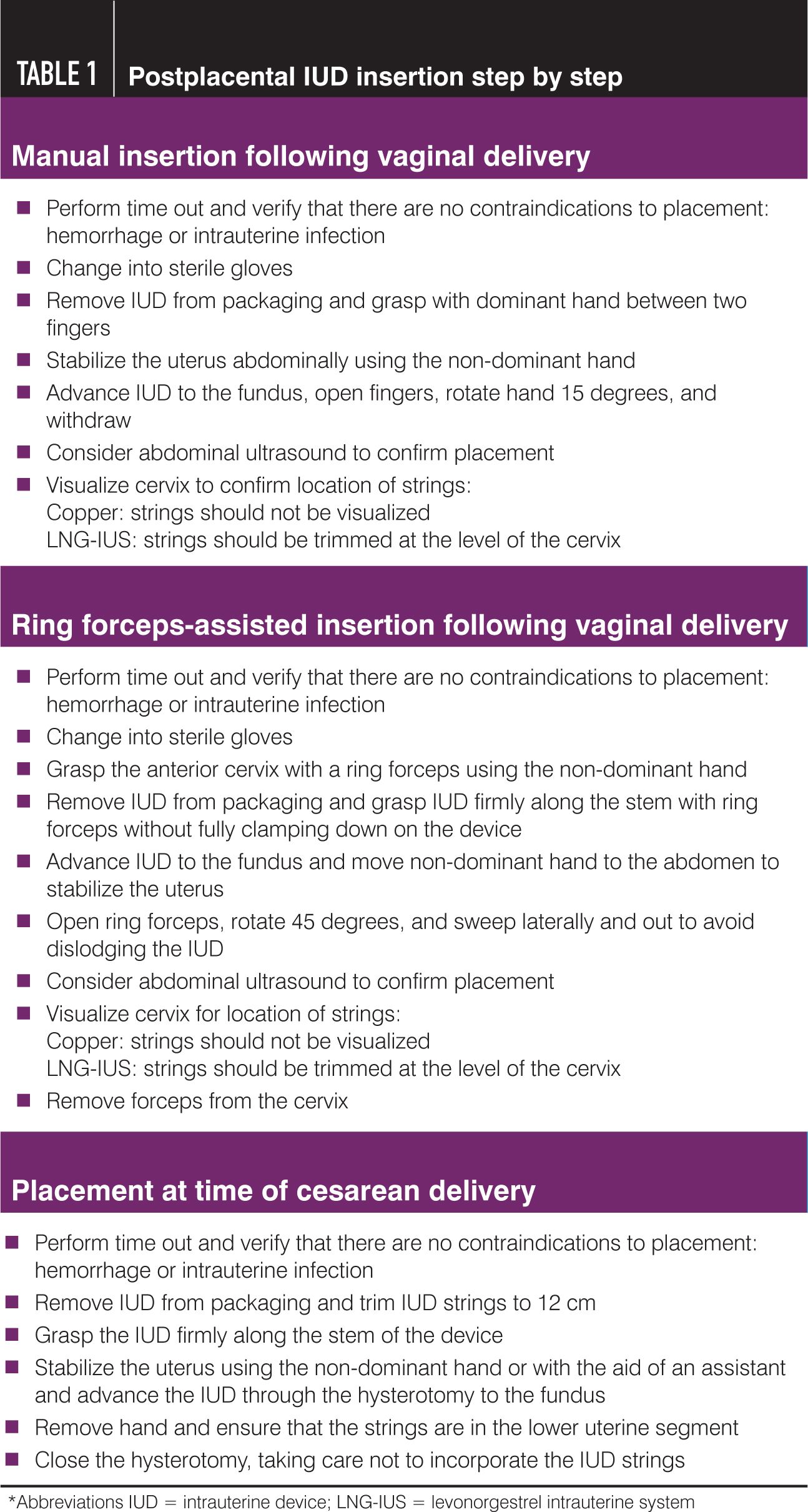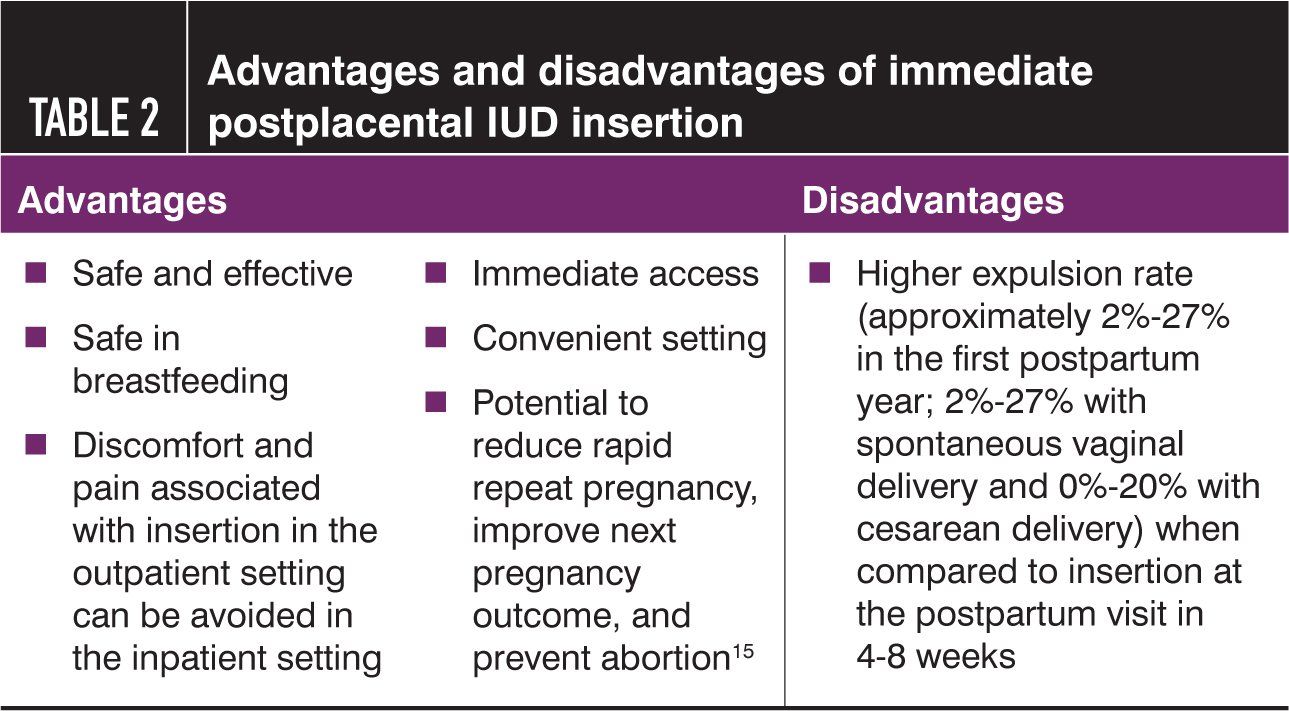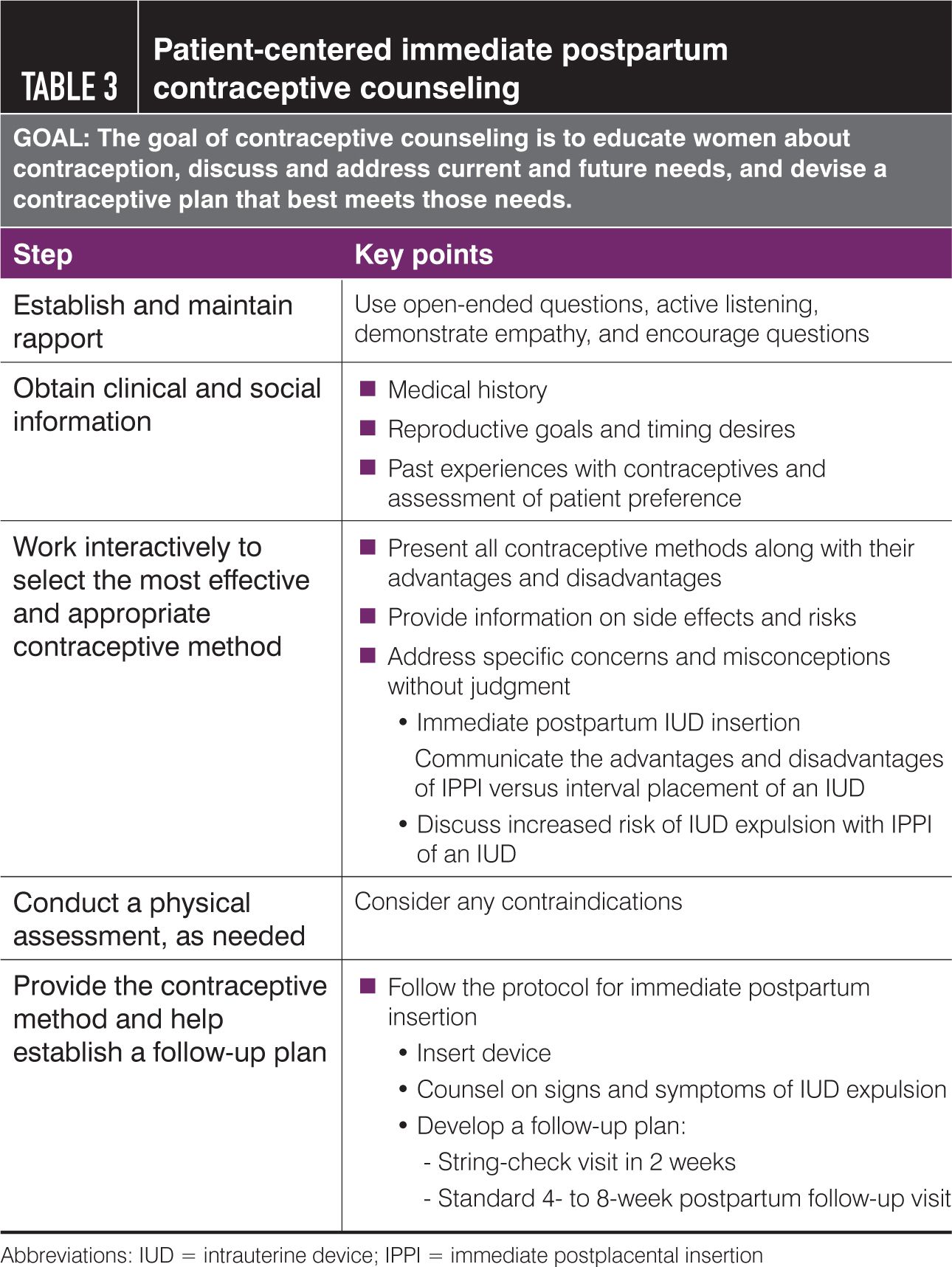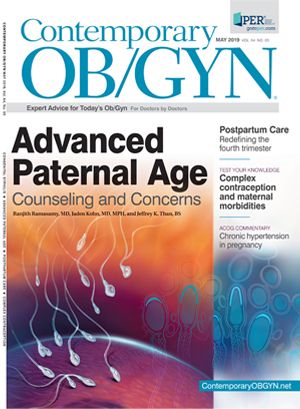Counseling on complex contraception dilemmas: Case 2
This installment in our series looks at postpartum contraceptive options for a pregnant patient with comorbidities
©rocketclips - stock.adobe.com

Table 1

Table 2

Table 3

Prenatal visits are an opportunity to discuss future fertility plans and contraceptive planning following delivery. As ob/gyns, we have a responsibility to ensure that women feel empowered to make contraceptive decisions that best fit their needs and desires. Thus, it is important to review patients’ medical comorbidities as well as their preferences and beliefs during prenatal care to develop a postpartum contraceptive plan.
A provider’s contraceptive counseling approach has implications for the patient-physician relationship, patient satisfaction, and contraceptive continuation. Studies have shown that patient satisfaction with counseling is correlated with higher rates of contraceptive use and greater satisfaction with contraceptive choice.1 High-quality, fair counseling should incorporate the concept of shared decision-making-in which the provider and the patient work collaboratively, with the provider offering medical information and expertise and the patient stipulating her experiences and preferences-in order to select a method that is safe, effective, and meets the needs, desires, and expectations of the patient.2 It is also important to recognize that disparities exist in contraceptive care because of racial, ethnic, and economic differences.3 In addition, there is the potential for bias in contraceptive counseling or recommendations.4
Case Nina, a 34-year-old G4P3 at 28 weeks’ gestation, presents for her prenatal appointment. Her medical history is complicated by chronic hypertension, controlled with labetalol and nifedipine, and Crohn’s disease without medications. She has an obstetric history significant for three preterm deliveries at 36, 35, and 34 weeks due to induction of labor for preeclampsia with severe features. Nina also has a complicated surgical history, with multiple bowel surgeries and a small bowel resection due to Crohn’s disease. She feels that this pregnancy will complete her childbearing and is interested in discussing birth control options. In addition, she is concerned because she will lose her health insurance 60 days after delivery and she wants to have an effective contraceptive method in place beforehand.
Considering Nina's medical history, what contraceptive method meets her desire to avoid pregnacny, minimize risks, and addresses her insurance coverage concerns follwoing delivery?
Postpartum sterilizationCombined hormonal contraceptionDepot medroxyprogesterone acetate (DMPA)Immediate postpartum intrauterine device
Correct answer: D. Immediate postpartum intrauterine device
Nina has indicated a desire to avoid additional pregnancies and a concern for lack of health insurance coverage in the future. Therefore, you and she may decide together to focus your counseling on long-acting reversible contraception (LARC), such as the intrauterine device (IUD) and the subdermal implant, and permanent contraception.
It is important to explore this patient’s and her partner’s interest in male sterilization or vasectomy, the safest and most effective form of permanent contraception, because permanent sterilization would help Nina to achieve her fertility goals. Female sterilization, however, may not be the safest contraceptive method, because Nina’s surgical history may complicate a surgeon’s ability to complete a tubal ligation or may put her at increased risk of surgical complications. LARC is both safe and extremely effective. Both the IUD and implant can be placed immediately postpartum, which may relieve this patient’s concerns about postpartum follow-up and insurance coverage. Alternatively, you can place the LARC at her postpartum visit.
Have you read: Counseling For Combined Hormonal Contraception
In regard to other contraceptive methods, combined hormonal contraception is contraindicated with this patient’s history of chronic hypertension. Progestin-only pills are safe; however, they may not be ideal, as they require daily dosing within a short window of time. DMPA is an option but, it may not be accessible to Nina if she loses health insurance. Her prenatal visit today is a good opportunity to explore her interest in LARC methods and timing of placement, her and her partner’s interest in vasectomy, and potential risks of female sterilization.
Reproductive life planning
One consideration in contraceptive counseling is the patient’s reproductive life plans, including wanting to avoid pregnancy or planning for a future pregnancy and its timing. A conversation about reproductive expectations provides an opportunity for the provider and patient to review medical comorbidities and for preconception counseling to be undertaken for women who want to become pregnant. The American College of Obstetricians and Gynecologists (ACOG) recommends that ideally, pregnancies be spaced by 18 months to allow for adequate physiologic preparation for a subsequent pregnancy and bonding between mother and child.5 Shorter interpregnancy intervals are associated with higher risk of preterm birth and low birth weight.6 Many women resume sexual activity prior to 6 weeks postpartum, and those who wait to initiate contraception may be at risk for short-interval pregnancy.7
Immediate postpartum LARC
Placement of LARC after birth before the mother is discharged allows a woman to leave the hospital with a highly effective contraceptive method. The U.S. Medical Eligibility Criteria for Contraceptive Use (US MEC) lists immediate postpartum LARC as category 1 or 2 for healthy breastfeeding or non-breastfeeding women, meaning that it is safe to use.8
Coverage and reimbursement
Until recently, reimbursement was uncommon for LARC devices and placement procedures in the inpatient setting. However, growing awareness of the importance of these procedures has pushed many states to revise their Medicaid policies to include reimbursement for immediate postpartum LARC in addition to the global fee for delivery.9 Additional efforts are being made to advocate for immediate postpartum LARC reimbursement from commercial payers.10 Ob/gyns should inquire about insurance coverage and discuss financial concerns with their patients so that information can be incorporated into the contraceptive plan prior to delivery and IUD insertion.
Implant placement
The contraceptive implant is an effective form of LARC that poses no increased risks when inserted during the postpartum stay. It is safe for women who want to breastfeed.8 Studies have shown that infant weight at 1 year, infant intake of breast milk, and volume and content of breast milk produced are not impacted by immediate postpartum insertion of the implant.11-13 In addition, there are few logistical barriers to immediate postpartum insertion. The implant can be inserted in the delivery room or at any time before discharge using the same technique as for interval insertion.14 There are no contraindications associated with postpartum insertion of the contraceptive implant.14
IUD insertion
Immediate postplacental insertion (IPPI) of an IUD is not only convenient for the patient, but also safe and effective for postpartum contraception (Table 1). It is important to review the advantages and disadvantages of such insertion (Table 2).15 IPPI is not associated with increased risks of infection, uterine perforation, or postpartum bleeding.16,17 It is an easy skill for ob/gyns to learn and requires little additional equipment. Furthermore, postplacental IUD insertion is safe for mother and infant during breastfeeding. Recent studies have shown that receiving an immediate postplacental hormonal IUD has no effect on time to lactogenesis, and there are no differences in reports of breastfeeding at 8 weeks postpartum between women whose IUDs were inserted immediately after delivery of the placenta and those in whom insertion was delayed.18 One disadvantage of IPPI compared to delayed insertion is a higher expulsion rate18 (approximately 2%-27% in the first postpartum year).
Contraindications to IPPI
There are few contraindications to IUD placement in general, including anatomic anomalies such as arcuate uterus, bicornuate uterus, or didelphys uterus; active pelvic infection; cervical cancer; and gestational trophoblastic disease. Postplacental IUD placement is contraindicated under the following conditions: intrauterine infection, postpartum hemorrhage, and puerperal sepsis.8,14
Procedure for IPPI
Assessment
Before beginning the insertion procedure, a brief history should be taken to assess for exclusion criteria, which include recent (within the last 3 months) or active intrauterine infection, known uterine cavity abnormality, and any absolute contraindications (e.g. Wilson’s disease). A postpartum history also should be taken to assess for exclusion criteria such as intrapartum fever greater than 38.0°C or clinical concern for chorioamnionitis, postpartum hemorrhage, and retained placenta requiring manual removal or dilation and curettage. Finally, timing should be confined to within 10 minutes of placental delivery. At that point, the IUD packaging can be opened for placement.
Insertion technique following vaginal delivery
A postplacental IUD can be inserted manually or with the aid of ring forceps (Table 1). First, grasp the IUD and advance it through the cervix. Next, place a hand abdominally to stabilize the uterine fundus. Advance the IUD to the fundus with confirmation from the abdominal hand. Release the IUD, taking care to avoid dislodging it from the fundus. At the provider’s discretion, ultrasound can be used to confirm the IUD location. Finally, inspect the vagina for proper string visualization. Because the Copper IUD strings are 12 cm, they are not expected to be visualized at or through the cervix after insertion; if the strings are visible, consider reinsertion of the IUD to ensure fundal placement. Most strings will pass spontaneously through the cervix and can be visualized and trimmed at a follow-up visit. The levonorgestrel (LNG)-IUS strings are longer, however, and should also be trimmed to the level of the cervix after insertion.
Insertion technique following cesarean delivery
If inserted following cesarean delivery, an IUD should be manually placed at the top of the uterine fundus. Before closing the uterine incision, place the strings in the lower uterine segment (LNG-IUS strings may need to be trimmed prior to placement). When the cervix is dilated, the strings will usually descend spontaneously through the cervix in the weeks following delivery. If the cervix is closed, strings may be left in the lower uterine segment or passed through the cervix with ring forceps. If a ring forceps is used, recheck to make sure the IUD remains at the fundus of the uterus before closing the uterine incision. The strings may be trimmed at a follow-up visit.
Special considerations
All pregnant patients should be screened for Chlamydia trachomatis and Neisseria gonorrhoeae and if the results are positive at any point, they must be treated prior to IUD placement. If a patient has not been screened prior to admission for delivery, a urine screening can be done then. If the results are found to be positive post-insertion, the patient can be treated with the IUD in place. Any clinical evidence of infection warrants consideration of IUD removal followed by treatment.
If postpartum endometritis is diagnosed after IUD insertion, remove the IUD and treat with intravenous antibiotics. The patient can then be counseled about the option of having an interval IUD insertion at a postpartum visit. Women with postpartum sepsis can have an interval IUD insertion 3 months after successful treatment of intrauterine infection.
Ultrasound follow-up is not required after postplacental IUD insertion. There are no data on malpositioned IUDs following postplacental insertion. Data from interval postpartum insertion have found no increased risk of pregnancy with a low-lying LNG-IUS,19,20 and there are no data to support increased risk of pregnancy with a low-lying Copper IUD.21
Follow-up
Before discharge, patients who have had postplacental IUD insertion must be instructed about its side effects, possible complications, and warning signs. They all should receive education on IUD expulsion and should be advised to call with expulsion concerns. Almost all expulsions occur in the first 3 months after insertion. In addition, patients should be aware that in the next few weeks, the IUD strings may descend to the introitus and that they can be shortened at a follow-up visit. All patients who have a postplacental IUD placement should be offered a visit in 2 weeks for a string check because the strings may be at the level of the introitus as the uterus subinvolutes postpartum. Women with postplacental IUD insertion should still be scheduled for routine postpartum follow-up at 4 to 8 weeks.
Choosing the best method
Postpartum contraceptive counseling is a multistep process that should be patient-centered (Table 3).22,23 For our patient Nina, discussing a contraceptive plan during her prenatal visits allows you to identify her fertility and contraceptive preferences and counsel her in a way that respects reproductive autonomy while minimizing coercive practices. LARC may be a good option for a woman like Nina who wants extremely effective contraception immediately following delivery. Immediate postpartum LARC is easy to place and one of many safe and effective options for postpartum contraception that can help to optimize birth spacing and decrease risk of unintended pregnancy. With relationship-building and thoughtful counseling, you can identify a safe postpartum contraceptive method that meets the needs and goals of patients like Nina.
Disclosures:
The authors report no potential conflicts of interest with regard to this article.
References:
- Koenig MA, Hossain MB, Whittaker M. The influence of quality of care upon contraceptive use in rural Bangladesh. Stud Fam Plann. 1997;28:278–289.
- Dehlendorf C, Krajewski C, Borrero S. Contraceptive counseling: Best practices to ensure quality communication and enable effective contraceptive use. Clin Obstet Gynecol. 2014;57(4):659-673.
- Dehlendorf C, Park SY, Emeremni CA, Comer D, Vincett K, Borrero S. Racial/ethnic disparities in contraceptive use: Variation by age and women’s reproductive experiences. Am J Obstet Gynecol. 2014;210(6):526.e1-526.e9.
- Dehlendorf C, Ruskin R, Grumbach K, Vittinghoff E, Bibbins-Domingo K, Schillinger D, et al. Recommendations for Intrauterine Contraception: A Randomized Trial of the Effects of Patients’ Race/Ethnicity and Socioeconomic Status. Am J Obstet Gynecol. 2010;203(4):319.e1-319.e8.
- Moniz MH, Spector-Bagdady K, Heisler M, Harris LH. Inpatient postpartum long-acting reversible contraception: Care that promotes reproductive justice. Obstet Gynecol. 2018;130(4):783-787.
- American College of Obstetricians and Gynecologists. Optimizing postpartum care. Committee Opinion No. 736. Obstet Gynecol. 2018;131:e140-150.
- Conde-Agudelo A, Rosas-Bermudez A, Kafury-Goeta AC. Birth spacing and risk of adverse perinatal outcomes: a meta-analysis. JAMA. 2006;295:1809-1823.
- Connolly A, Thorp J, Pahel L. Effects of pregnancy and childbirth on postpartum sexual function: a longitudinal prospective study. Int Urogynecol J Pelvic Floor Dysfunct. 2005;16:263-267.
- Curtis KM, Tepper NK, Jatlaoui TC, Berry-Bibee E, Horton LG, Zapata LB, et al. U.S. Medical Eligibility Criteria for Contraceptive Use, 2016. MMWR Recom Rep. 2016;65(3):1-103.
- Moniz, MH, Dalton, VK; Institute for Healthcare Policy & Innovation. Reimbursement for immediate postpartum contraception outside the global fee: Improving outcomes and reducing costs for moms and babies. https://ihpi.umich.edu/sites/default/files/iplarc_021418.pdf. Published February, 2018. Accessed February 8, 2019.
- Centers for Disease Control and Prevention. The 6|18 Initiative: Prevent unintended pregnancy, evidence summary. https://www.cdc.gov/sixeighteen/docs/6-18-evidence-summary-pregnancy.pdf. Published December, 2015. Accessed February 8, 2019.
- Carmo LSMP, Braga GC, Ferriani RA, Quintana SM, Vieira CS. Timing of etonogestrel-releasing implants and growth of breastfed infants: A randomized controlled trial. Obstet Gynecol. 2017;130(1):100-107.
- Braga GC, Ferriolli E, Quintana SM, Ferriani RA, Pfrimer K, Vieira CS. (2015). Immediate postpartum initiation of etonogestrel-releasing implant: A randomized controlled trial on breastfeeding impact. Contraception. 2015;92(6):536-542.
- Reinprayoon D, Taneepanichskul S, Bunyavejchevin S, Thaithumyanon P, Punnahitananda S, Tosukhowong P, et al. Effects of the etonogestrel-releasing contraceptive implant (Implanon®) on parameters of breastfeeding compared to those of an intrauterine device. Contraception. 2000;62(5):239-246.
- Rodriguez M, Evans M, Espey E. Advocating for immediate postpartum LARC: Increasing access, improving outcomes, and decreasing cost. Contraception. 2014;90(5):468-471.
- Grimes DA, Lopez LM, Schulz KF, Van Vliet HA, Stanwood NL. Immediate post-partum insertion of intrauterine devices. Cochrane Database Syst Rev. 2010;12(5):CD003036.
- Whitaker AK, Chen BA. Society of Family Planning Guidelines: Postplacental insertion of intrauterine devices. Contraception. 2018;97(1):2-13.
- Turok DK, Leeman L, Sanders JN, Thaxton L, Eggebroten JL, Yonke N, et al. Immediate postpartum levonorgestrel intrauterine device insertion and breast-feeding outcomes: A noninferiority randomized controlled trial. Am J Obstet Gynecol. 2017;217(6):665.e1-665.e8.
- Braaten KP, Benson CB, Maurer R, Goldberg AB. Malpositioned intrauterine contraceptive devices: risk factors, outcomes, and future pregnancies. Obstet Gynecol. 2011;118(5):1014-1020.
- Pakarinen P, Luukkainen T. Five years’ experience with a small intracervical/intrauterine levonorgestrel-releasing device. Contraception. 2005;72(5):342-345.
- Anteby E, Revel A, Ben-Chetrit A, Rosen B, Tadmor O, Yagel S. Intrauterine device failure: relation to its location within the uterine cavity. Obstet Gynecol. 1993;81(1):112-114.
- Zapata LB, Murtaza S, Whiteman MK, Jamieson DJ, Robbins CL, Marchbanks PA, et al. Contraceptive counseling and postpartum contraceptive use. Am J Obstet Gynecol. 2015;212(2):171 e171-178.
- Gavin L, Moskosky S, Carter M, Curtis K, Glass E, Godfrey E, et al. Providing quality family planning services: Recommendations of CDC and the U.S. Office of Population Affairs. MMWR. 2014;63(4):7-13.

Recap on reproductive rights with David Hackney, MD, MS
December 20th 2022In this episode of Pap Talk, we spoke with David Hackney, MD, MS, maternal-fetal medicine physician at Case Western Reserve University and chair of ACOG's Ohio chapter for a full recap of where restrictions on reproductive rights have been and where they're going.
Listen
In this episode of Pap Talk, Gloria Bachmann, MD, MSc, breaks down what it means to be a health care provider for incarcerated individuals, and explores the specific challenges women and their providers face during and after incarceration. Joined by sexual health expert Michael Krychman, MD, Bachmann also discusses trauma-informed care and how providers can get informed.
Listen
No link found between hormonal contraception and clitoral adhesion severity
February 28th 2025A recent study presented at the ISSWSH 2025 Annual Meeting found no significant association between hormonal contraceptive use and the severity of clitoral adhesions, though researchers emphasize the need for further investigation.
Read More
